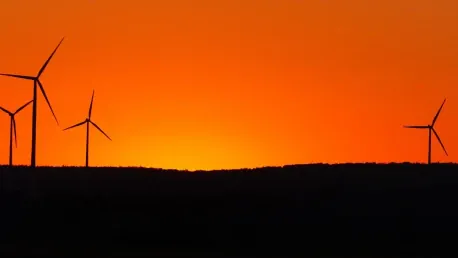In a landmark decision, a European energy firm, Enel Energy, has been ordered to dismantle 84 wind turbines installed on Osage lands in Oklahoma by December 1, 2025. This historic ruling marks a significant victory for the Osage Nation, which has long fought to protect their mineral rights and resources. The decision not only underscores the importance of respecting Native American rights but also sets a precedent for similar conflicts between indigenous groups and large corporations with green energy projects. It illuminates broader tensions between sustainable energy initiatives and the rights of Native American tribes.
The central theme revolves around the conflict between Enel Energy and the Osage Nation over the construction of wind turbines on lands that involve complex ownership, including surface and mineral rights. This case exemplifies the intricate and often contentious interplay between pursuing renewable energy and safeguarding the resources and rights of Native American tribes. The implications of this ruling stretch beyond the immediate parties, influencing the broader wind energy industry and reinforcing the necessity of proper consultations and respect for indigenous rights in similar future ventures.
The Legal Battle Unfolds
Initial Reports and Federal Judge’s Mandate
Initial reports from early 2024 highlighted that a federal judge had mandated the removal of the wind farm, but specifics regarding the timeline and compensation had not been clearly defined at that time. This ambiguity led to ongoing legal proceedings aimed at elucidating the full extent of the consequences for Enel Energy’s actions. Without a clear directive, the company and the Osage Nation continued to navigate a complex and volatile legal landscape.
Recently, Judge Jennifer Choe-Groves of the U.S. Court of International Trade provided a definitive deadline for the removal of the wind turbines and outlined the financial responsibilities of Enel Energy. By December 1, 2025, the company must dismantle the turbines and restore the land to its original state. Beyond the physical dismantling, Enel has also been ordered to pay approximately $4 million in damages, addressing issues of conversion, trespass, and covering substantial attorney fees. This ruling clarifies the previously ambiguous mandate and delineates the clear repercussions for the company’s prior actions.
Osage Nation’s Response
The Osage Minerals Council expressed profound gratitude for the court’s decision, emphasizing the enduring significance of defending their mineral estate. Their response underlined the importance of maintaining autonomy over their resources and protecting their lands against external threats. This victory was not only legal vindication but also a cultural and moral triumph for the Osage people, reinforcing their rights and historical claims over the disputed lands.
In addition to celebrating the ruling, the Osage Nation reiterated their openness to future collaborations with partners who approach negotiations in good faith. They emphasized their willingness to engage in projects that respect their rights and resources, signaling a potential for constructive partnerships with entities willing to honor their sovereignty. This approach underscores the importance of mutual respect and proper negotiation practices, potentially serving as a model for future interactions between energy firms and Native American tribes.
Ownership and Rights Conflict
Surface Rights vs. Mineral Rights
The crux of the conflict lies in the distinction between the surface rights leased by Enel Energy and the mineral rights held by the Osage Nation. While Enel Energy had secured a lease for 8,400 acres of surface rights to construct the wind farm, the Osage Nation retained title to the mineral rights beneath the land. This ownership entailed the area necessary for maintenance roads and other infrastructural needs connected to the wind turbines. This duality of ownership created a unique legal landscape, fraught with potential conflicts of interest.
Despite early warnings from the Bureau of Indian Affairs dating back to 2011, Enel Energy proceeded with the construction, involving significant excavation and unauthorized removal and use of Osage minerals. This action blatantly ignored established regulations and the explicit rights of the Osage Nation, leading to the current legal repercussions. Such disregard for proper legal channels and the rights of mineral owners has become a central point of contention in this case, highlighting the importance of respecting comprehensive property rights in similar ventures.
Enel Energy’s Arrogance and Disregard
The company’s continued arrogance and disregard for multiple warnings and orders to obtain a mining lease and halt mineral violations culminated in its costly legal defeat. Despite explicit orders and formal requests from the Bureau of Indian Affairs and the Osage Nation, Enel Energy persisted in its willful neglect of these directives. This behavior not only undermined the legal authority of indigenous rights but also showcased a broader corporate disregard for ethical business practices.
This persistent defiance of regulatory and community standards ultimately led to Enel Energy’s downfall, resulting in significant financial and legal repercussions. The company’s actions were more than just breaches of protocol; they were emblematic of a larger issue of corporate entities overriding indigenous rights for profit. This ruling serves as a potent reminder to other corporations of the potential consequences of such negligence and the importance of adhering to legal and ethical standards in all business operations.
Financial and Legal Consequences
Cost of Dismantling and Damages
The estimated cost of removing the 84 wind turbines stands at a staggering $300 million, marking a severe financial blow to Enel Energy. These costs encapsulate the price of dismantling, transportation, and land restoration, reflecting the extensive efforts required to revert the land to its original state. The financial ramifications for Enel Energy extend beyond the immediate dismantling expenses, signifying a substantial hit to the company’s fiscal goals for 2025.
Beyond the dismantling costs, Judge Choe-Groves awarded monetary damages totaling over $300,000 for conversion and trespass, coupled with substantial attorney fees exceeding $36 million. This financial burden is expected to significantly impact Enel Energy’s operational and fiscal strategies, demonstrating the profound implications of legal compliance failures. By placing these financial responsibilities on Enel Energy, the court has reinforced the principle that companies must adhere to legal standards and respect indigenous rights to avoid severe legal and financial penalties.
Broader Implications for the Wind Energy Industry
Robert Bryce, an energy expert, underscored the broader implications of this ruling for the wind energy industry. He noted that the industry has benefited from federal tax credits despite facing controversies related to the environmental and property impacts of wind turbines. This decision sets an important precedent, demonstrating that rural communities and Native American tribes can effectively challenge and prevail against powerful energy companies. The ruling could potentially lead to stricter adherence to regulations and more respectful engagement with affected communities in future renewable energy projects.
The case of Enel Energy and the Osage Nation serves as a powerful example of the potential legal and financial risks associated with disregarding local and indigenous rights. It signals a shift towards greater accountability within the wind energy sector and possibly beyond, encouraging companies to approach negotiations and projects with heightened sensitivity and respect for the communities they impact. This precedent reinforces the importance of thorough compliance and consultation in the development of renewable energy infrastructure, emphasizing ethical practices in pursuing sustainability goals.
Historical Context and Ongoing Struggle
Osage Nation’s Long Fight for Rights
The historical context of the Osage Nation’s struggle to protect their lands and resources is deeply rooted. The Osage have been fighting for their rights for over 150 years, ever since they purchased the land from the Cherokees in the late 1800s. This victory is seen as a significant milestone in their ongoing efforts to defend their mineral estate for future generations. Their history is a testament to the resilience and determination of the Osage people in safeguarding their resources against external encroachments.
This long history of struggle underscores the enduring importance of land and resource rights for Native American tribes. The Osage Nation’s victory in this case is not merely a legal win but a reaffirmation of their historical claims and continued sovereignty over their lands. It also serves as an inspiration to other indigenous groups facing similar challenges, highlighting the possibility of achieving justice and protecting rights through legal avenues.
Legal Precedents and Future Collaborations
This historic ruling is a significant victory for the Osage Nation, which has long fought to protect their mineral rights and resources. The decision underscores the importance of respecting Native American rights and sets a precedent for conflicts between indigenous groups and large corporations involved in green energy projects. It highlights the broader tensions between sustainable energy initiatives and the rights of Native American tribes.
The central issue is the conflict between Enel Energy and the Osage Nation over the wind turbines on lands with intricate ownership that includes surface and mineral rights. This case exemplifies the complex interplay between pursuing renewable energy and protecting Native American tribes’ resources and rights. The implications go beyond the immediate parties, influencing the wind energy industry and emphasizing the need for proper consultations and respect for indigenous rights in future projects.









